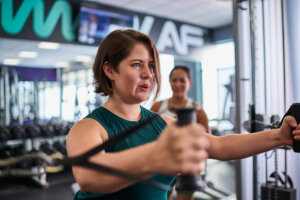Weight loss is one of the most common fitness goals — a quick Google search of “how to lose weight” yields thousands of results, from fad diets to body treatments and fitness challenges. There’s a lot of weight-loss advice out there, so finding legitimate information (and determining what works best for you) can be challenging and even overwhelming.
Here’s the truth: There’s no magic bullet to help you lose weight, and workout and diet plans aren’t one-size-fits-all. Losing weight is an individual journey that looks different for everyone, but don’t be discouraged. We’re here to break down the basics of how to lose weight, including tips to make nutrition work for you and a realistic 4-week workout plan for weight loss.
How weight loss works
First, what causes weight loss to happen? How do you know when your body is burning fat? Let’s take a look at the process.
Fat loss vs. weight loss
First thing’s first: When people say they’d like to lose weight, their actual goal is usually fat loss — and one of the most common misconceptions in fitness is that seeing a lower number on the scale means you’re losing fat.
The number on the scale is your total mass weight, which is made up of everything in your body: your bones, muscles, water levels, and fat. Your total weight can fluctuate daily depending on those factors, but fat loss is a slower process that occurs when you expend more calories than you’re consuming.
How to burn fat
In general, the amount of fat you burn comes down to your overall energy balance. In other words, energy that comes in (nutrition) vs. energy out (activity). Your daily total energy needs are known as your total daily energy expenditure (TDEE). Your TDEE is determined by your base metabolic rate (BMR) and your activity level.
Determine your BMR
Your BMR is your base metabolic rate, the amount of energy expended while your body is at rest. Everyone has a unique BMR that can be estimated with a basic formula — or if math isn’t your thing, you can get your BMR directly from an Evolt 360 body composition scan at your Anytime Fitness gym.
Determine your activity level
The TDEE formula multiplies your BMR by a specific factor that’s determined by your typical activity level. Here’s the breakdown:
- Sedentary (1.2): Minimal activity throughout the day, with little to no exercise.
- Lightly Active (1.375): Less than 30 minutes of activity throughout the day, including 15 minutes or less of high-intensity exercise.
- Moderately Active (1.55): 90 minutes of moderate exercise per day or 50 minutes of high-intensity exercise per day.
- Very Active (1.725): You are active throughout the entire day or you experience 2 hours or more of intense exercise per day.
Determine your TDEE
Let’s put it all together: BMR x Activity Level = TDEE
Here’s an example. A moderately active 30-year-old female who’s 5’6″ and weighs 150 pounds has a BMR of 1,417 calories per day.
1,417 (BMR) x 1.55 (moderate activity level) = 2,196.35 (TDEE)
As a rule of thumb, if weight loss (and fat loss) is one of your health and fitness goals, your TDEE should generally be greater than your daily calorie intake. When your daily activities require more energy than you’re bringing in nutritionally, your body will use excess fat stores for energy, resulting in weight loss.
Can you spot-reduce body fat?
One of the most common myths about weight loss is that you can target fat loss to specific areas of your body. Unfortunately, that’s not the case — there are no magic “fat-burning exercises” or “best exercises for weight loss” that target specific areas of fat.
While you can’t spot reduce body fat, you can target and strengthen specific muscle groups. With regular exercise and strength training for weight loss, your body will start to lose fat in all areas, including your face, tummy, arms, and legs.
The basics of weight loss
We’ve got the technical stuff out of the way, but losing weight isn’t always as simple as counting calories, cutting carbs, or doing more reps. There are several factors that impact weight loss — and contribute to a healthy body weight. Let us explain.
Diet and nutrition
Whether you’re strength training to gain muscle or hitting the gym to establish healthy routines, the right diet is key to reaching your health and wellness goals. Your body needs fuel to function properly, even when you’re in a calorie deficit to lose weight.
Focus on eating a balanced diet full of:
- Whole fruits and vegetables
- Complex carbs
- Lean proteins
- Whole grains
- Fatty acids
- Oils
- Low-fat or fat-free dairy
A note on hydration and weight loss
Contrary to popular belief, drinking water will not make you feel full or help you consume fewer calories, but it can aid digestion — and it’s critical to your overall health.
Exercise
The next critical piece of the weight loss puzzle is, of course, exercise.
How much exercise? According to the current Physical Activity Guidelines for Americans, adults need at least 150 minutes of moderate exercise and 2 days of strength training per week. That could look like:
- Hitting the gym for 30 minutes, 5 days a week
- Hitting the gym for 50 minutes, 3 days a week
- Strength training at home or at the gym 2 days a week
- Going on brisk walks throughout the week
No matter what your workout routine looks like, the most important thing is to get your body moving regularly. The best exercises for weight loss are the ones that you enjoy, so find what works best for you.
Is cardio good for weight loss?
Cardio is an important part of a weight-loss exercise plan (cardio burns major calories, after all), but it should be balanced with strength training, flexibility work, and recovery to prevent injury and maximize the effectiveness of your weight-loss training plan.
In fact, strength training for weight loss could help you reach your health goals faster. Building muscle helps your body burn more calories even when you’re at rest — and maintaining muscle requires more energy than maintaining fat.
Sleep
Want the results of your weight-loss training plan to last? Hit the hay. Regular sleep patterns can not only help you lose weight, but also maintain a healthy weight over time.
Rest and recovery
That’s right! Rest days are another critical component of an effective weight-loss exercise plan. No matter your fitness level, your body needs time to recover and repair muscle after intense exercise. In fact, working out too much could hinder you from achieving your fitness goals.
Incorporate active recovery into your gym routine to improve your flexibility, boost your mood, increase your energy levels, and help you stick to your weight loss training plan. Try one of these activities on your next rest day:
- Dynamic stretching
- Light cardio like jogging on the treadmill or riding on the stationary bike
- Rock climbing
- Swimming
- Taking a long walk
- Yoga
How to set weight-loss goals
Weight loss may be a goal in your health journey, but it isn’t the sole determinant of your success. Look for non-scale victories along the way, like meeting new friends at the gym or being able to lift heavier weights than before.
Remember that weight loss will look different for everyone, and you may even gain weight when you start working out — it’s perfectly normal and can even be a good sign.
When you set a weight-loss goal, make sure it’s a SMART one:
- Specific
- Measurable
- Attainable
- Relevant
- Time-based
Instead of setting an unrealistic or uninformed goal, evaluate your current fitness level and experience, then set action-based goals rather than result-based goals. For example:
- Result-based goal: Lose 10 pounds by the end of the month.
- Action-based goal: Visit the gym 3 days a week for a month.
When you set action-based goals, you’ll be more likely to stick to your weight loss workout plan and see the results you want.
4-week weight loss workout plan
Other weight-loss workout plans might require you to work out 7 days a week, eliminate carbs, shred calories, or push your body beyond its limit, but those tactics often result in burnout and hinder your progress.
The most important part of any workout plan for weight loss is regular physical activity. This plan features a combination of strength training, cardio workouts, endurance training, and recovery to get you started, but it’s not prescriptive or one-size-fits-all. Give it a try to find out what works best for you, then adjust your workouts accordingly.
Note: If weight is a specific health concern for you, talk to your doctor before starting a routine that involves cardio and strength training for weight loss.
Week 1: Weight-loss exercise plan
Week one features a full-body circuit workout, a heart-pumping cardio workout, and a strengthening arm workout spaced out with active recovery days.
Week 2: Weight-loss exercise plan
This week features two forms of cardio — rowing and biking — plus a full-body ladder workout. Focus on the quality of your reps in each set.
Week 3: Weight-loss exercise plan
You’re past the halfway mark! This week’s weight-loss workout plan features a bonus workout you can do if you want to keep the burn going.
Week 4: Weight-loss exercise plan
For the final week, you’ll hit two full-body workouts and a distance rowing workout. See if you can challenge yourself to do a few extra reps or sets this week, or do the bonus workout.
When will I see results from a weight-loss exercise plan?
With a regular weight-loss workout plan, you should start to notice results in a few weeks. But if you step onto the scale and don’t see the number going down, don’t be discouraged. There are several reasons you might not be seeing the results you want in the gym.
After completing the 4-week weight-loss workout plan, take stock of how your body feels. Are you more energized? Do you feel stronger? Are you fatigued? Make adjustments to your workout routine or diet plan accordingly.
For example: If you need more of a challenge, add more reps or sets to your strength workouts, or try to increase the speed or incline of your next treadmill workout. If you’re feeling exhausted, make active recovery a higher priority or assess your diet plan to ensure you’re fueling your body properly.
How to track your progress
When you’re working toward a fitness goal, tracking your workouts and your progress can:
- Keep you accountable and motivated
- Help you set realistic goals and adjust as needed
- Lead to better results in the long run
Stepping onto the scale can help you track your progress, but it doesn’t always give you a complete picture of your health. To look deeper than the number on the scale, try a body composition scan with a tool like the Evolt 360, which is available in many Anytime Fitness gyms (how convenient!).
Body composition scanners can give you a holistic view of your body composition with detailed measurements, including:
- Fat mass
- Muscle mass
- Body fat percentage
- Visceral fat
- Biological age
As you navigate your weight-loss journey, metrics like fat mass may decrease while muscle mass increases — signs of better overall health. That’s worth more than what the number on the scale might tell you!
A final word on weight loss
Body weight can be a sticky subject, and while weight loss is a common goal, it’s important to remember that weight is just one indicator of your overall health.
If you’re trying to lose weight, be patient with yourself and focus on the journey — prioritizing your health and wellness is a win in itself! With consistency and dedication (and yes, a little sweat), you’ll create healthy habits that last long after you achieve your weight-loss goals.
More workouts to lose weight and tone up
Team up with an Anytime Fitness Coach to get extra support for your weight loss journey, including personalized workout plans, nutrition advice, and accountability. Claim your free session with a Coach to get started.



